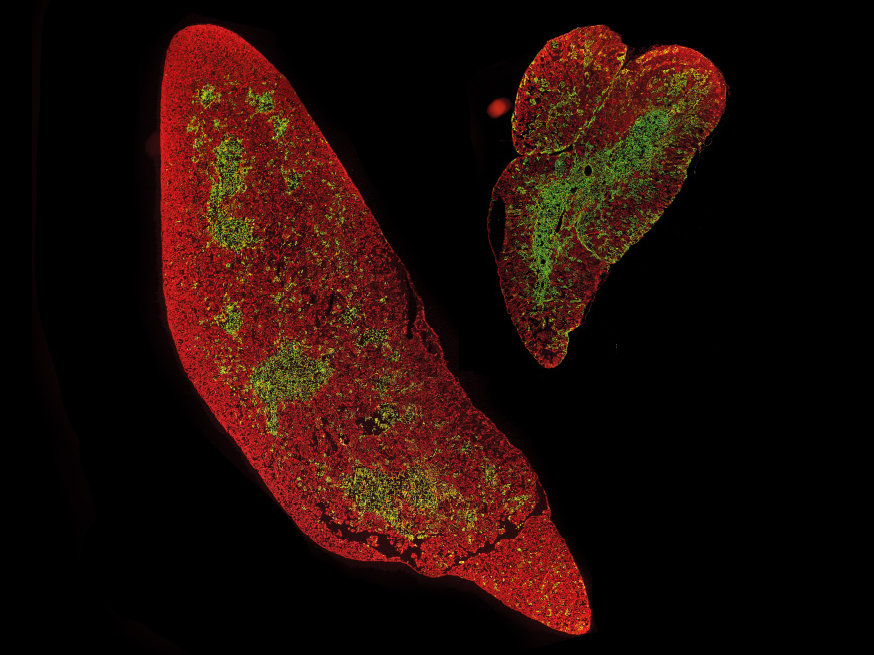Max Planck researchers identify epithelial stem cells that control thymic growth at different stages of life.
Many immune cells, which are crucial to our immune system, develop in early life and into adolescence in a small organ next to our heart: the thymus. But with age the thymus shrinks and its function diminishes and thus the number of powerful immune cells decreases. Max Planck’s research groups from Freiburg and Würzburg have now identified the processes that control the development and formation of thymic tissue over the course of life. They also came across potential therapies for age-related shrinkage of the thymus and for autoimmune diseases.
© MPI Immunobiology and Epigenetics, Boom
The tissue structure of the stimulated thymus organ does not differ from that of the non-stimulating organ. As evidence of a well-functioning thymus, the edges (red) and inner (green) regions are sharply separated from each other.
© MPI Immunobiology and Epigenetics, Boom
The thymus is a central organ of the immune system. This is where those T cells that, as killer cells, recognize and destroy virus-infected or decaying cells, are formed, as well as the so-called helper T cells, which help the body to form antibodies.
Over the past few decades, Thomas Bohm’s research group at the Max Planck Institute for Immunology and Epigenetics in Freiburg has been able to identify the genetic switches required in the thymus for T-cell maturation. The so-called thymic epithelial cells, which attract T-cell precursors and bring them to maturity, are necessary here. T cells learn to distinguish between diseased cells, healthy cells, and foreign cells from their own. With it, you can detect and eliminate unwanted structures and prevent autoimmune diseases. Previous work in Thomas Bohm’s laboratory has shown that the two major forms of thymic epithelium arise from bipotent progenitor cells. However, it is not yet clear whether there is more than one type of precursor and how many subspecies in which the precursors are distinguished.
Lineage analysis identifies progenitor cells of the thymic epithelium
In cooperation with Dominic Green Laboratory (formerly the Max Planck Institute for Immunobiology and Epigenetics, now the Max Planck Research Group at the University of Würzburg), a specialist in single-cell molecular analysis, researchers have now molecularly recorded the astonishing large variability of thymic epithelial cells. Algorithms developed in Grün’s laboratory for accurate characterization of differences in the genetic activity of individual cells made it possible to identify cells with potential precursor activity.
In a second step, these predictions were validated experimentally by the researchers using the ‘bar coding’ system developed in Thomas Bohm’s laboratory using the CRISPR gene scissors. The bar coding process makes it possible to provide progenitor cells with a molecular signature that is transmitted by all cells that emerge from the progenitors. This makes it possible to derive a family tree of epithelial cells.
Anja Nusser of the Boehm lab and Sagar of the Grün lab have developed a method that links information from a family tree to the molecular characteristics of individual cells. This made it possible for the first time to study the development of the thymic epithelium at different ages. This description is of particular interest to immunologists because the thymus undergoes significant changes throughout life. In the early stages of development, there is rapid organ growth and associated massive T-cell production, while in aging there is a gradual loss of functional epithelial cells in the thymus and consequently decreased T-cell production. Age-related loss of function is associated with a weakened immune system.
The arrangement of progenitor cells determines the composition of thymic tissue
© MPI Immunobiology and Epigenetics, Boom
Massive hypertrophy of the stimulating thymus organ even in young mice, which is largely preserved in old age.
© MPI Immunobiology and Epigenetics, Boom
In their analysis, the researchers were able to identify two groups of bipotent precursors of the thymic epithelium. The ‘early’ ancestral population assumes the major role in thymic formation during the embryonic stage and in the adolescent organism, while the later ‘postnatal’ ancestral population largely determines further thymic formation in adulthood. The composition of the thymic epithelium is modulated differently by the chronology of the progenitor population.
At early time points, thymic cortical epithelial cells are formed, which mainly contribute to the production of T cells, while at later time points, the main production is on medullary epithelial cells, which ensures that self-reactive T cells are not released from the thymus into the body and thus Make an important contribution to autoimmune protection.
New ways to increase thymus function
The skillful combination of genetically modified animal models from the Boehm laboratory with the latest methods for single-cell characterization in the Grün working group allowed researchers to study the effect of the method of epithelial cell proliferation, which has been known for years, on the thymus. It was of great interest to determine whether early stimulation of the thymus with a special growth factor leads to undesirably faster consumption of stem cells and consequently to premature shrinkage of the thymus.
The team’s data suggests that’s not the case. “The thymus we stimulated in an old mouse is still larger than that in a young unstimulated mouse. The structure of the stimulated thymus tissue also demonstrates the normal structure of cortical areas and medulla regions within the organ,” says Max Planck Director Thomas Bohm. With these findings, the Freiburg researchers laid the foundation for the development of new therapeutic approaches to treat age-related thymic shrinkage and treat T-cell-dependent autoimmune diseases.
terabyte / mr

“Total coffee aficionado. Travel buff. Music ninja. Bacon nerd. Beeraholic.”











More Stories
Coral Seeding: Artificial Insemination Makes Coral More Heat Tolerant
Fear, Anger, and Denial: How People Respond to Climate Change – Research
LKH Graz: Using radiation to combat heart arrhythmias